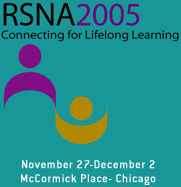
Abstract Archives of the RSNA, 2005
SSK06-06
Contrast-enhanced Ultrasound Patterns of Hepatocellular Carcinoma: Correlation with Histologic Tumor Differentiation
Scientific Papers
Presented on November 30, 2005
Presented as part of SSK06: ISP: Ultrasound (Liver: Contrast)
Dania Cioni MD, Abstract Co-Author: Nothing to Disclose
Riccardo Antonio Lencioni MD, Presenter: Nothing to Disclose
Laura Crocetti MD, Abstract Co-Author: Nothing to Disclose
Clotilde Della Pina, Abstract Co-Author: Nothing to Disclose
Jacopo Lera, Abstract Co-Author: Nothing to Disclose
Carlo Bartolozzi MD, Abstract Co-Author: Nothing to Disclose
To correlate the contrast-enhanced ultrasound (US) patterns of hepatocellular carcinoma (HCC) with the degree of tumor differentiation as assessed at pathology examination.
Twenty-seven small (3 cm or less) HCC lesions in 21 cirrhotic patients were examined with contrast-enhanced US as part of an on-going prospective clinical trial. Contrast-enhanced US examinations were performed with low mechanical index (0.01-0.04), real-time scanning (Contrast Tuned Imaging; Technos MPX, Esaote Biomedica, Genoa, Italy) after bolus injection of 2.4 ml of a second-generation contrast agent (SonoVue; Bracco, Milan, Italy). All patients underwent liver transplantation within 1-3 months. Explanted livers were serially sectioned at 5-mm thickness with all nodular lesions grossly identified and examined. Contrast-enhanced US patterns were correlated lesion-by-lesion with the degree of tumor differentiation.
At pathology, six (22%) of the 27 US-detected HCC lesions were well differentiated tumors, 14 (52%) of 27 were moderately differentiated tumors, and seven (26%) of 27 were poorly differentiated tumors. In the arterial phase of the contrast-enhanced US examinations, 23 (96%) of 27 HCC lesions showed strong and homogenenous contrast uptake, while the remaing four lesions, that were all found to be well differentiated tumors at pathology, did not show any clear-cut arterial contrast uptake. In the portal phase of the contrast-enhanced US examinations, 22 (81%) of 27 HCC lesions were isoechoic, while the remaing five lesions, that were found to be moderately (n = 1) or poorly (n = 4) differentiated tumors at pathology, were hypoechoic. In the delayed phase of the contrast-enhanced US examinations, 20 (74%) of 27 HCC lesions were isoechoic, while the remaing seven lesions, that were found to be moderately (n = 3) or poorly (n = 4) differentiated tumors at pathology, were hypoechoic.
Contrast-enhanced US patterns correlate well with the degree of tumor differentiation of HCC.
Cioni, D,
Lencioni, R,
Crocetti, L,
Della Pina, C,
Lera, J,
Bartolozzi, C,
Contrast-enhanced Ultrasound Patterns of Hepatocellular Carcinoma: Correlation with Histologic Tumor Differentiation. Radiological Society of North America 2005 Scientific Assembly and Annual Meeting, November 27 - December 2, 2005 ,Chicago IL.
http://archive.rsna.org/2005/4414785.html

